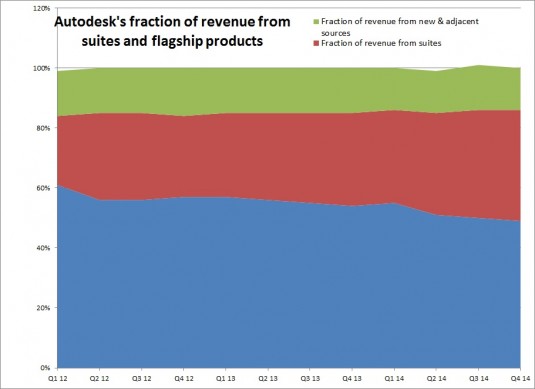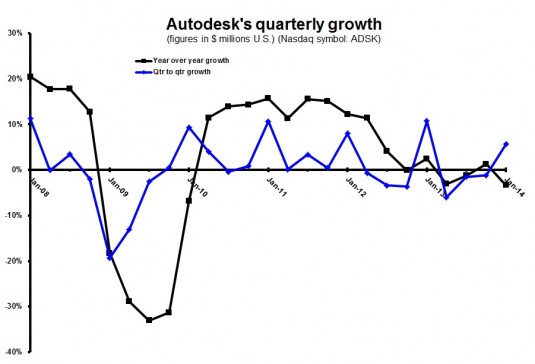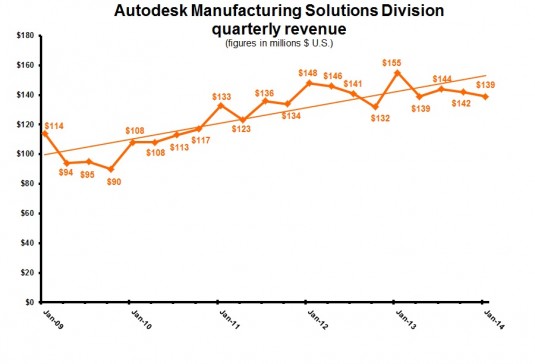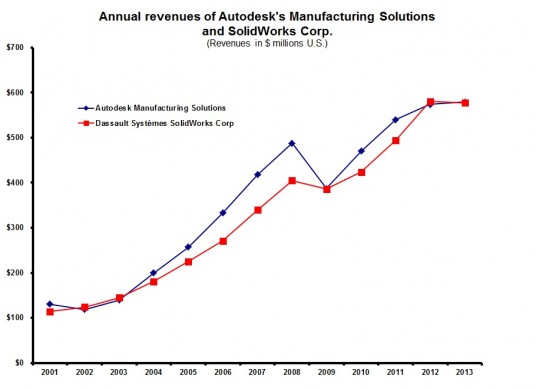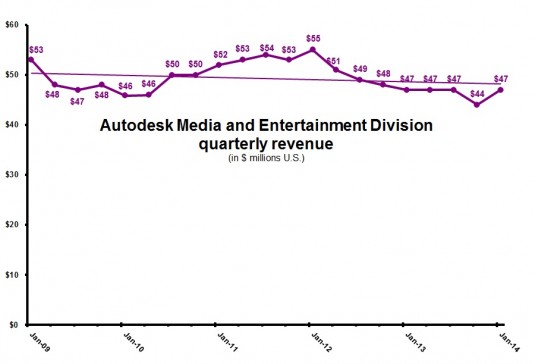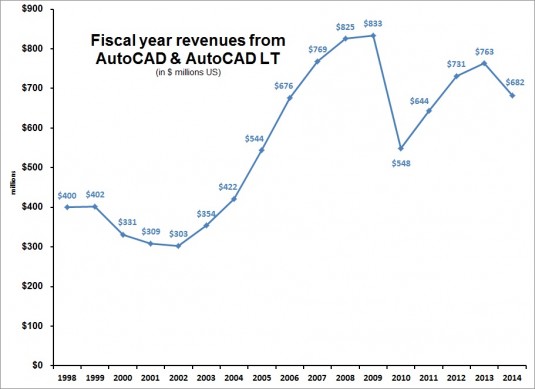Fourth-quarter revenue down 3%; fiscal year revenue down 1.6%. PLM 360 has best quarter ever as cloud products become popular with early adopters.
By Randall S. Newton
There is an old saying in law school: When you don’t have facts, argue the law. When you don’t have the law, argue facts. When you don’t have either, pound your fist on the table. For Autodesk, reporting fourth quarter and full-year results is a case of picking what to promote and what to ignore. CEO Carl Bass isn’t exactly pounding the table, but the usual metrics are not in Autodesk’s favor at the moment. Revenue and net profit were down, so instead the focus was on growth in cloud-based products and the transition to rental income that will occur over the next few years.

Revenue for the fourth quarter of fiscal 2014 (ended January 31, 2014) was $587 million, down 3% from $606.9 million a year ago. Full year revenue was $2.3 billion, down 1.6%. By comparison:
- Dassault Systèmes was up 5% for the fourth quarter and the full year;
- PTC was up 5% in the fourth quarter (ending in September) and 3% for the full year.
- Ansys was up 7% in the fourth quarter, and 7.9% for the full year.
Autodesk net income in the fourth quarter was $53.9 million, down 27% from a year ago. For the fiscal year net income was $228.8 million, down 7.5% from FY2013. Autodesk says its ongoing business model transition to not only suites but to cloud and subscription-based revenue is impacting short-term results. In the fourth quarter, Autodesk says the transition impacted revenue by approximately $30 million, with particular impact on license revenue in the Americas and the AEC business segment.
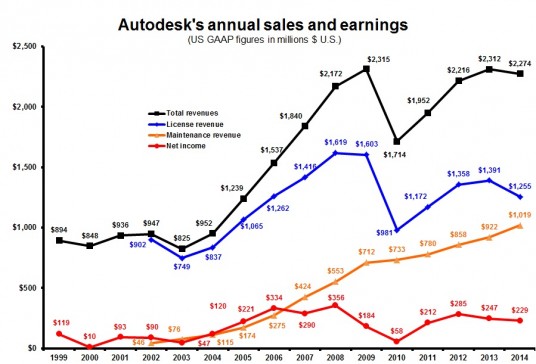
In prepared remarks announcing the results, Bass referred to good growth for the cloud-based products, especially the new “360” cloud-based products like BIM 360 and Sim 360. PLM 360 topped $700,000 in sales for its best quarter ever. “We are at the very beginning of a platform and model transition that will propel Autodesk to the future,” Bass added. “We are focused on driving our subscription base, annual subscription value, and billings over the next four years and beyond. As anticipated, our transformation will start gradually and we expect will gain momentum as we go forward.” Bass characterized the sales of the various “360” products as strong among early adopters, and noted that most PLM 360 sales were to new-to-Autodesk customers.
Fourth quarter of fiscal year 2014 details
Revenue by region:
- Americas revenue was $207 million, down 6% from 4Q13
- EMEA revenue was $229 million, up 3.6% a year earlier
- Asia Pacific revenue was $150 million, up 1% from a year earlier
- Revenue from emerging economies was $88 million, up 4.7% and represented 15% of total revenue in the fourth quarter.

Revenue by business segments:
- Revenue from the Platform Solutions and Emerging Business (PSEB) segment was $196 million, down 1% (this continues a trend; segment business in 4Q13 was down 7% from 4Q12).
- Revenue from the AEC business segment was $196 million, down 5.3% from a year earlier
- Revenue from the Manufacturing business segment was $154 million, flat compare to 4Q13
- Revenue from the Media and Entertainment business (M&E) segment was $41 million, down 12% from a year earlier
- Revenue from Flagship products was $288 million, down 12% from a year earlier
- Revenue from Suites was $216 million, up 15% compared to the fourth quarter last year
- Revenue from New and Adjacent products was $83 million, down 7.777% from a year earlier.
Even though most of these metrics are down, Autodesk was upbeat about the long term. “We were pleased with our fourth quarter performance, which included strong growth in cash flow from operations, solid growth in deferred revenue, and a significant sequential increase in backlog,” said Mark Hawkins, Autodesk executive vice president and CFO. “We remain confident in our long-term model, which calls for a 12% billings compounded annual growth rate, 20% more annual value from our new and existing subscriptions, and a 50% increase in subscriptions by the end of our fiscal 2018.”
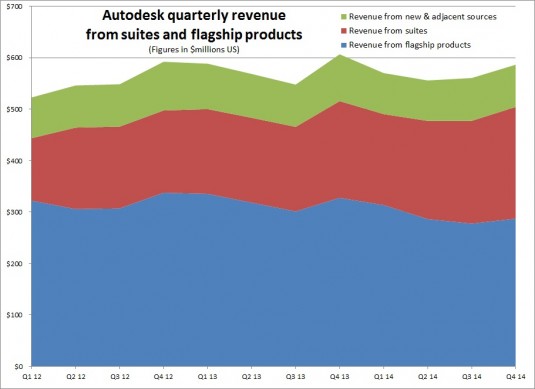
Full year details
Revenue by region:
- Americas revenue was $819 million, down 2% from FY13
- EMEA revenue was $852 million, down 2% from a year earlier
- Asia Pacific revenue was $603 million, down 0.9% from a year earlier
- Revenue from emerging economies was approximately $345 million, represented 15% of total revenue in the fourth quarter.
Fraction of FY2014 revenue from various segments:
- Revenue from flagship products: 51% (down 4 points from FY2013)
- Revenue from suites: 30% (down 4 points from FY2013)
- Revenue from new and adjacent products: 14% (down 1 point from FY2013)
- Revenue from AutoCAD line: 30% (down 3 points from FY2013)
In offering guidance for fiscal year 2015, which started February 1, 2014, Autodesk expects 3%-5% revenue growth, 5%-8% net billings growth, and net new subscription additions of 150,000 to 200,000. During the question and answer period with Wall Street analysts, Bass noted how the new subscription model makes it harder to break out “seats sold.” For example, if a subscribing user of Inventor subscribes to Revit, there is no additional seat to count. Bass said the company would work on ways to help analysts look inside sales better going forward.
What do we think?
It used to be a given that software companies were growth companies (growth of 10% or better). Microsoft put that notion to rest several years ago, and the major CAD/PLM players are now following along. The decline reported here doesn’t compare to 2010 when we were in the heart of The Great Recession, but instead comes when the global construction industry is enjoying a recovery. Technology trends are causing Autodesk to move to a more comprehensive subscription model, but there is no guarantee it will lead to stronger growth in the future.
L. Stephen Wolfe, P.E., a contributing analyst for Jon Peddie Research, provided research for this report.
Nine more of our custom charts follow. Larger versions of these charts are available at our Facebook page, www.facebook.com/GfxSpeak.


